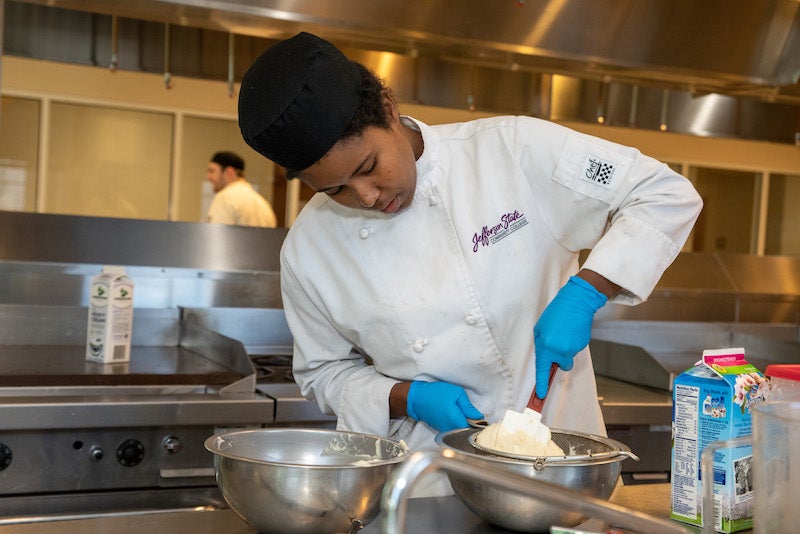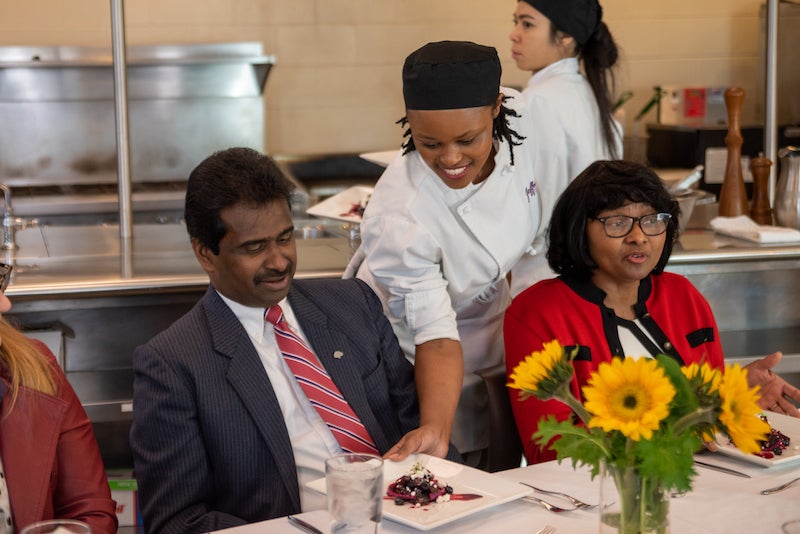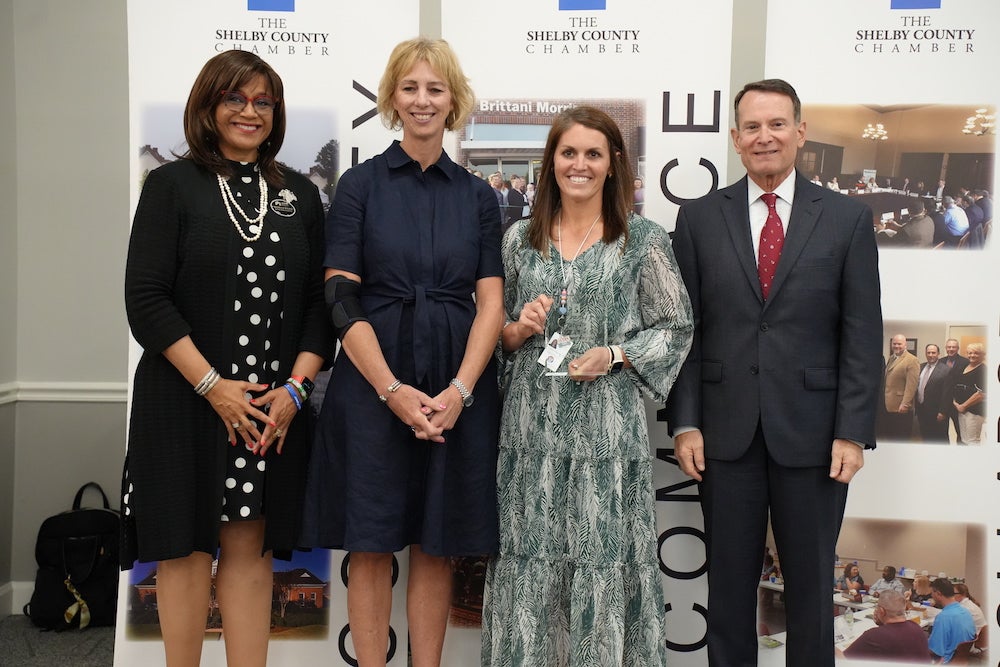Students in Jeff State’s culinary program are mastering health-conscious techniques that don’t skimp on flavor.
A four-course meal served on a white tablecloth is not a normal lunch for most people, especially in the middle of a workday. But it’s what the students in Chef Joseph Mitchell’s Advanced Nutrition class at the Jefferson State Community College Shelby-Hoover Campus whipped up for guests as an end-of-semester project and served with a side of scrupulous notes about the nutritional value of each dish. And—spoiler alert—it ended with many in attendance pausing their praises of the students’ work only to ask for the recipes.

The meal was more than just a fancy lunch for guests, although it did carry the quality and presentation of a fine dining experience, complete with attentive table service. The four-course medley of gourmet cuisine was also an experiential presentation through which the students tested their cooking skills and shared what they had learned about ingredient selection and nutrition with a new audience—a diverse group comprised of administrators from dietetics departments at local universities, students with a culinary background studying dietetics, and other members of the community connected to the initiative Mitchell is leading at JSCC to strengthen nutrition education. What better way to prove that healthy food doesn’t have to be bland than to recruit a few taste-testers to try it?

With their task before them, students Maya Hawkins, James Brantley and their classmates rolled up their sleeves and got to work, planning and executing the luncheon from start to finish. Maya and her three group members prepared and served a blueberry tarragon tart with hazelnut crust for dessert. For Maya, the project mirrored her experiences working as a line cook at The Club in Birmingham “It was very similar to how we would present some other dishes at The Club,” she says. “We were working on timing, and that was a nice practice. Some people might not have had all the work experience, but for me, it was something I was comfortable with.”

James was comfortable with the project, too, mostly because of his work at another Birmingham restaurant. He and his group members were responsible for making and serving the main entrée of the luncheon: ricotta and goat cheese gnocchi with Tuscan kale sauce. “We had a textbook that broke down the healthy cooking,” he says. “We had previously cooked several of the entrées. We came to an agreement as a class that that was our favorite entrée, and a good one to choose for the luncheon.”

James’s group modified the recipe a bit, using some whole wheat flour and adding red pepper flakes to the kale sauce for extra seasoning. For the most part, however, they followed the recipe as it was written since it met the group’s high level of nutritional criteria. “We didn’t want to change the overall recipe too much because we thought it was nutritionally very sound,” he says. “We were happy with the nutritional content of it. It was pretty much what we had wanted it to be.”
As director of Hospitality and Culinary Management at JSCC, Mitchell was eager to share an overview of the changes he is spearheading in the post-secondary culinary curriculum “to reflect the modern challenges of the foodservice industry,” and the need for culinary professionals to partner with members of the government, academic and medical communities “to help inform consumer(s), strengthen nutrition education and develop healthier product choices.” Along with the addition of Advanced Nutrition classes, the name for the degree option is now Culinary Nutrition Management from Food Service/Culinary Management. JSCC has also added a certificate in Culinary Nutrition Management and formed articulation agreements with Montevallo’s nutrition program, plus a path for Samford University nutrition students to take Culinary Nutrition Certificate at JSCC.

“We are changing our philosophy position on how we approach nutrition in our curriculum development,” Mitchell says. “We have modified our program’s mission statement to reflect this: ‘We advocate sustainability in food preparation practices and strive to educate our students both personally and professionally of an understanding of how healthy food choices and food preparations affect both themselves and society.’ We’ve identified that consumers are looking for more healthy foods.”
In less formal terms, the new curriculum aims at giving students a foundation in healthy cooking techniques (steaming rather than frying foods, for instance), and how seemingly small changes can combat health conditions such as heart disease, high cholesterol and diabetes. The curriculum also allows students to compare ingredients and calculate the nutritional value of meals based on ingredients’ components. “It’s a journey,” Mitchell says. “We’re not trying to eliminate, but we are trying to make the dishes healthier.”

And in the spirit of professionalism, students weren’t just focused on the taste and nutritional value of each dish they served at their luncheon. They plated the gnocchi, blueberry tart and the other two courses (tortilla soup and red salad) as if they were being served to the most prestigious of food critics. “Presentation is huge when it comes to working in the restaurant industry,” James says. “They say you eat with your eyes first. Not only do you want to execute the taste, but the presentation as well.”
Maya says she has always been interested in making food for people with special diets, so the Advanced Nutrition class was a natural fit for her interests. Plus, it showed her the benefits of certain ingredients used in moderation and how a variety of foods served in smaller portions can be just as filling as one large portion of something in a meal. “I think it was really eye-opening for me,” she says. “It was great to get hands-on experience with it and learn what ingredients I can use to make a variety of dishes. It was nice getting to try something new that I hadn’t experienced in any other class or out in the field.”

James says he learned he didn’t have to sacrifice flavor—or presentation—for better nutrition. “Cooking on the healthier side doesn’t have to be bland,” he says, with all the confidence of someone who just aced his final exam—or, in this case, final meal project. “I thought we executed it well.”










